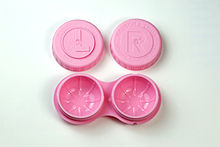User:User dH7PyyVSv9/Contact Lens Care Sandbox
Care
[edit]
While daily disposable lenses require no cleaning, other types require regular cleaning and disinfecting in order to retain clear vision and prevent discomfort and infections by various microorganisms including bacteria, fungi, and Acanthamoeba, that form a biofilm on the lens surface. There are a lot of products that are used to cleans contact lenses:
- Multipurpose solutions – The most popular cleaning solution[clarification needed] for contact lenses; these are suitable for rinsing, disinfecting, cleaning and storing lenses, and in most cases eliminate the need for protein removal enzyme tablets. Some multipurpose solutions are not effective at disinfecting Acanthamoeba from the lens.[1] In May 2007, one brand of multipurpose solution was recalled due to a cluster of Acanthamoeba infections.[2][3] Newer generations of multipurpose solutions are effective against bacteria, fungi, and acanthamoeba and are designed to condition the lenses while soaking.
- Saline solution – Used for rinsing the lens after cleaning and preparing it for insertion. Saline solutions do not disinfect.
- Daily cleaner – Used to clean lenses on a daily basis. A few drops of cleaner are applied to the lens while it rests in the palm of the hand, and the lens is rubbed for about 20 seconds with a fingertip (depending on the product) on each side. Long fingernails can damage lenses.
- Hydrogen peroxide solution – Used for disinfecting the lenses, and available as 'two-step' or 'one-step' systems. With 'two-step' products, the peroxide must be rinsed away with saline before the lenses may be worn, because hydrogen peroxide is an irritant and strong oxidizer.[4]
- Enzymatic cleaner – Used for cleaning protein deposits off lenses, usually weekly, if the daily cleaner is not sufficient. Typically, this cleaner is in tablet form. Protein deposits make use of contact lenses uncomfortable, and may lead to various eye problems.
- Ultraviolet, vibration or ultrasonic devices – Used to both disinfect and clean contact lenses. The lenses are inserted inside the portable device (running on batteries and/or plug-in) for 2 to 6 minutes during which both the microorganisms and protein build-up are thoroughly cleaned. Saline solution is typically used as multi-purpose solutions are not necessary. These devices are not usually available in optic retailers but are in some electro-domestic stores.[5][6][7]
Some products must only be used with certain types of contact lenses. Water alone will not adequately disinfect the lens, and can lead to lens contamination and has been known in some cases to cause irreparable harm to the eye.[8] Proper lens cleaning is important in warding off biofilm formation.
To keep the cleaning product as clean as possible, and to counteract minor contamination of the product and kill microorganisms on the contact lens, some products contain preservatives such as thiomersal, benzalkonium chloride, and benzyl alcohol. In 1989, thiomersal was responsible for about 10% of problems related to contact lenses:[9] because of this, many products no longer contain thiomersal. Preservative-free products usually have shorter shelf lives. For example, non-aerosol preservative-free saline solutions can typically be used for only two weeks once opened. The introduction of silicone-hydrogel soft contact lens materials in 1999 made selection of the proper disinfecting solution more important.
References
[edit]- ^ Hiti, K; Walochnik, J; Haller-Schober, E M; Faschinger, C; Aspöck, H (February 2002). "Viability of Acanthamoeba after exposure to a multipurpose disinfecting contact lens solution and two hydrogen peroxide systems". British Journal of Ophthalmology. 86 (2): 144–146. doi:10.1136/bjo.86.2.144. PMC 1771011. PMID 11815336.
- ^ Early Report of Serious Eye Infections Associated with Soft Contact Lens Solution. CDC health advisory. May 25, 2007. CDCHAN-00260-2007-05-25-ADV-N
- ^ Acanthamoeba Keratitis --- Multiple States, 2005–2007. Center for Disease Control MMWR dispatch. May 26, 2007 / 56(Dispatch);1–3
- ^ Hughes, Reanne; Kilvington, Simon (July 2001). "Comparison of Hydrogen Peroxide Contact Lens Disinfection Systems and Solutions against Acanthamoeba polyphaga". Antimicrobial Agents and Chemotherapy. 45 (7): 50–57. doi:10.1128/AAC.45.7.2038-2043.2001. PMC 90597. PMID 11408220.
- ^ "How Optical Ultrasonic Cleaners Work".
{{cite journal}}: Cite journal requires|journal=(help) - ^ White, Gina. "Caring for Soft Contact Lenses".
{{cite journal}}: Cite journal requires|journal=(help) - ^ Ward, Michael. "Soft Contact Lens Care Products".
{{cite journal}}: Cite journal requires|journal=(help) - ^ Contact Lens Wearing Guide
- ^ Wilson-Holt N, Dart JK. "Thiomersal keratoconjunctivitis, frequency, clinical spectrum and diagnosis." Eye. 1989;3 ( Pt 5):581–7. PMID 2630335
